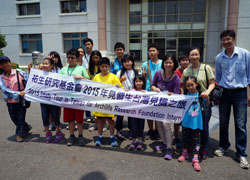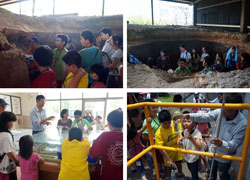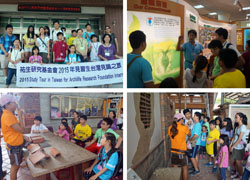Sketch of Archilife Study Tour, August 2015Date: 2015-09-19
Section: Activity |  8月份見識之旅活動,於2015年8月1日由呂明澐小姐帶領13位祐生見習生及家長,進行大樹濕地保育暨三和瓦窯百年古蹟之旅。活動開始之初,領隊呂明澐小姐提醒本次活動注意事項及觀察重點,先行建立見習生的背景知識。 8月份見識之旅活動,於2015年8月1日由呂明澐小姐帶領13位祐生見習生及家長,進行大樹濕地保育暨三和瓦窯百年古蹟之旅。活動開始之初,領隊呂明澐小姐提醒本次活動注意事項及觀察重點,先行建立見習生的背景知識。
For the tour of August 1, 2015, Ms. Lu Ming-yun led 13 ARF interns and their parents on a tour to Dashu Wetland and San-he Tile Kiln. At the start of the day's activities, team leader Ms. Lu Ming-yun reminded everyone about things to note and what to observe, and gave the interns some background knowledge.
 上午行程首先來到高雄大樹區的傳統木炭窯場,此處的林木資源豐富,更曾是全台木炭窯數量最多最集中的地方,然因時空環境改變漸趨沒落,目前僅剩二家業者苦撐經營,至今仍保留原始木炭的製造,導覽人員首先帶領眾人於木炭窯觀看木炭的製造過程與燒製時利於熱氣流通的木炭排列方式,並解釋透過窯上煙囪所冒出煙的顏色來判定窯內木炭燒製的進度,讓眾人對木炭製成作業有更進一步的了解。接著,眾人前往不遠處的大樹污水處理廠進行參訪,此座新建民生污水處理廠不僅處理民生污水,亦兼具消毒功能,有效減輕高屏溪流域的污染負荷,過程中由廠長及專業技術人員親自帶領,解說污水處理流程,並於廠內逐一講解機械的運作原理與方式,最後更直接於地下水道讓見習生體驗取水,親眼見證由污水經過處理後搖身一變,成為透明無臭味的乾淨水,過程中充滿驚奇,眾人皆留下深刻印象。 上午行程首先來到高雄大樹區的傳統木炭窯場,此處的林木資源豐富,更曾是全台木炭窯數量最多最集中的地方,然因時空環境改變漸趨沒落,目前僅剩二家業者苦撐經營,至今仍保留原始木炭的製造,導覽人員首先帶領眾人於木炭窯觀看木炭的製造過程與燒製時利於熱氣流通的木炭排列方式,並解釋透過窯上煙囪所冒出煙的顏色來判定窯內木炭燒製的進度,讓眾人對木炭製成作業有更進一步的了解。接著,眾人前往不遠處的大樹污水處理廠進行參訪,此座新建民生污水處理廠不僅處理民生污水,亦兼具消毒功能,有效減輕高屏溪流域的污染負荷,過程中由廠長及專業技術人員親自帶領,解說污水處理流程,並於廠內逐一講解機械的運作原理與方式,最後更直接於地下水道讓見習生體驗取水,親眼見證由污水經過處理後搖身一變,成為透明無臭味的乾淨水,過程中充滿驚奇,眾人皆留下深刻印象。
The first leg of the morning's itinerary was the traditional charcoal kilns in the Dashu District of Kaohsiung. Cradled amidst an abundance of forest resources, the area once had the highest concentration of kilns in Taiwan. However, as time goes by and the environment changes, there are now only two charcoal makers left retaining the primitive way of making charcoal. The tour guide led everyone to the kiln to watch the manufacturing of charcoal. He showed how the arrangement of the logs facilitates heat circulation during the carbonizing process and explained that the color of smoke coming out from the top of the kiln is used to assess the progress of the carbonization, furthering everyone's knowledge on charcoal production. The second leg of the morning's itinerary was the nearby Dashu Wastewater Treatment Plant. The newly built wastewater treatment plant not only processes household wastewater but also sanitizes it, effectively alleviating pollution level in the Gaoping River Basin. During the tour, the plant manager and technical personnel personally explained the wastewater treatment process, and the operating principle and method of each machine. At the end of the tour, the interns even experienced getting water from the sewer from witnessing for themselves how the wastewater was treated and turned into clear, odorless and clean water. The surprise-filled experience left a deep impression in everyone's mind.
 下午於舊鐵橋園區內乘涼享受完午餐後,眾人步行前往鄰近的農友種苗場進行參訪,此種苗場除了於世界各地成立農作物與花卉種苗保存及復育外,也積極開發新品種。導覽人員透過教學背板解說農友種苗行的品種改良成果,介紹過程豐富,琳琅滿目的各式蔬果種類及命名方式也讓眾人大開眼界。接著來到三和瓦窯,三和瓦窯為高雄地區三級古蹟與台灣歷史建築百景,目前為第五代子孫經營,過程中由熱情的導覽人員帶領眾人實際進入窯場參觀,並解說傳統建築物中,不同造型的瓦片所象徵的意義與特色。最後,眾人於舊鐵橋溼地園區內參觀,導覽人員沿途介紹新、舊鐵橋的歷史與溼地內所生長的特殊植物,眾人皆收穫良多。至此,本日活動已近尾聲,大家一起合照留念後返回台北,並期待於下次見識之旅再相見。 下午於舊鐵橋園區內乘涼享受完午餐後,眾人步行前往鄰近的農友種苗場進行參訪,此種苗場除了於世界各地成立農作物與花卉種苗保存及復育外,也積極開發新品種。導覽人員透過教學背板解說農友種苗行的品種改良成果,介紹過程豐富,琳琅滿目的各式蔬果種類及命名方式也讓眾人大開眼界。接著來到三和瓦窯,三和瓦窯為高雄地區三級古蹟與台灣歷史建築百景,目前為第五代子孫經營,過程中由熱情的導覽人員帶領眾人實際進入窯場參觀,並解說傳統建築物中,不同造型的瓦片所象徵的意義與特色。最後,眾人於舊鐵橋溼地園區內參觀,導覽人員沿途介紹新、舊鐵橋的歷史與溼地內所生長的特殊植物,眾人皆收穫良多。至此,本日活動已近尾聲,大家一起合照留念後返回台北,並期待於下次見識之旅再相見。
Lunch was taken in the cool shade of the Old Railroad Bridge Education Wetland Zone. After lunch, everyone walked to the nearby Known-You nursery. It apart from preserving and restoring crops, flowers, seeds and seedlings around the world, the company also actively develop new species. The tour guide used teaching boards to explain Know-You Seed Company's achievement in improving plant varieties. The myriad variety of fruits and vegetables, and various methods of naming them, were an eye-opening experience for everyone. The next destination of itinerary was San-he Tile Kiln. San-he Tile Kiln is a Class-III historical relic of the Kaohsiung area and one of top hundred architectural wonders in Taiwan. It is currently run by fifth generation owners. During the tour, everyone visited the actual kiln area and tour guide explained the meaning and characteristics of different tiles in traditional buildings. Finally, everyone had a tour around the Old Railroad Bridge Education Wetland Zone. The tour guide introduced the history of the old and new bridges, and plants unique to the wetland, helping everyone gain useful knowledge. At this point, the day's itinerary came to an end. Everyone boarded the bus to Taipei after taking a group photo and looked forward to the next study tour.
|
|